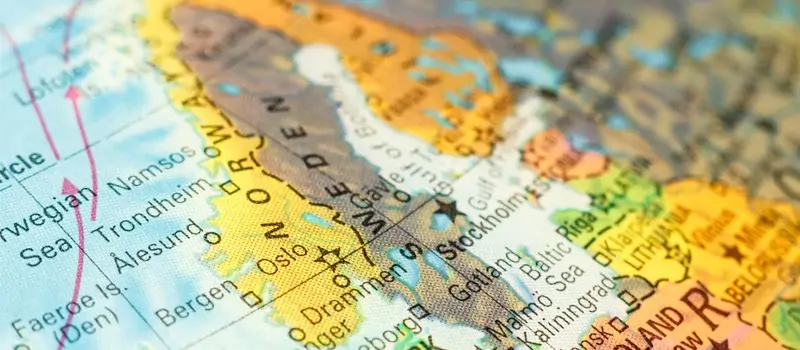If any of your ancestors come from Europe, then there is a fairly good chance that you will have some Scandinavian DNA. In fact, many people who get their ethnicity results from a genealogical DNA test are surprised by just how much Scandinavian ancestry they have.
If your research hasn’t led you to any Scandinavian ancestors yet, you may be questioning just how accurate the test results are. Where did those genes come from? How did they work their way into your genetic mix?
There are more answers to those questions than you might think.
What is Scandinavia?
Let’s begin by defining what we mean by Scandinavia and what it means to have Scandinavian DNA. You probably already have a general idea, but we want to be specific. When we’re talking about Scandinavia from a genetic viewpoint, rather than a geographic or political one, the region includes:
- Norway
- Sweden
- Denmark (for the most part)
- Iceland
- Greenland
Iceland and Greenland are quite distant from the other countries geographically, but they were settled by Scandinavians, and carry their genetic heritage. Denmark, on the other hand, has strong Scandinavian roots, but many families there have Germanic ancestors as well.
Although Finland shares borders with both Norway and Sweden, and it was even ruled by Sweden for hundreds of years, it is typically not considered part of Scandinavia. It has its own unique history, language, and culture. However, many people living in Finland today have Swedish ancestors, and Swedish remains one of its official languages.
The Vikings traveled (a lot)
While Scandinavian DNA is naturally most often found in the countries listed above, it can be found in many other places as well. And the main reason for that was the Vikings.
The Vikings originated in southern Scandinavia, including present-day Sweden, Norway, and Denmark. The area is not as well suited for agriculture as other parts of Europe, and the Vikings depended on the sea to provide much of their food. This led to the Vikings becoming excellent sailors, and they used that skill to trade and settle where they could, and to raid and plunder everywhere else.
From the 8th to the 11th centuries, the Vikings sailed far from their homelands, to all points of Europe and beyond. They discovered and established colonies in Iceland and Greenland, and made it as far as North America by 1000 A.D. They were just as successful on land, pushing their way through Russia to Constantinople and into the Middle East. The raided northern Europe and the British Isles on many occasions, and established settlements in Scotland, Ireland, France, and along the Baltic coast.
In fact, three Vikings even ruled England as its kings from 1016-1042. Just a few years later, in 1066, the Normans conquered England, but who were the Normans originally? Vikings who settled in northern France.
At the same time the Vikings were spreading their influence (and DNA) around Europe, they carried slaves back with them when they returned home. This led to an influx of non-Scandinavian DNA into the region, along with cultural influences from other areas.
Naturally, Vikings did not survive by raiding alone. In fact, they spent most of their time farming, fishing, crafting, and trading. Even for those who did go raiding, it was far more often an occasional adventure than a full-time career.
The three kingdoms
Many small, independent kingdoms existed throughout the Viking age in Scandinavia. During the 11th century, they began merging together into three major kingdoms: Norway, Sweden, and Denmark.
At the same time, Christianity, which had been introduced to the region a couple hundred years earlier, finally began to gain a solid hold. The Catholic Church established its first dioceses in Scandinavia during the 11th century, and created an archbishopric there by 1103 A.D.
The Scandinavians of this time stopped raiding their neighbors, and began to turn their military pursuits in new directions. Sigurd I of Norway launched an expedition in 1107 to sail through the Mediterranean to support the newly formed Kingdom of Jerusalem, while Swedish and Danish warriors fought in the Baltics during the 12th and 13th centuries to spread Christianity in that region.
Island settlements
The Scandinavians established lasting colonies on a number of islands in the north Atlantic, many of which survive to this day. They still carry the distinct marks of Scandinavian culture and DNA.
The Vikings settled the Faroe Islands around 800 A.D., some 200 miles north-northwest of Scotland. From there, they soon discovered Iceland, and established the first permanent settlement there around 870 A.D. Those islands have been populated by Scandinavians ever since.
In 985 A.D., Erik the Red discovered Greenland, and established a colony there soon after. Despite lasting close to 500 years, those original colonies failed. But the Danes founded several new towns in Greenland during the 18th century.
Just off the shore of Scotland, the Vikings settled on Shetland, Orkney, the Hebrides, and many smaller islands, in addition to their incursions onto the mainland. These islands remained under Scandinavian influence much longer than the mainland settlements. In fact, the Hebrides were not ceded to Scotland until 1266, and Orkney and Shetland remained Scandinavian until the middle of the 15th century.
What does this mean for genealogy?
Many people are surprised when they receive the results of their genealogical DNA test. Whether they got tested by Ancestry DNA, 23andMe, MyHeritage, or some other company, anyone with European ancestors is likely to show some degree of Scandinavian ancestry. In fact, a lot of people have a much higher percentage than they expected.
If you have more Scandinavian ancestry than you thought you would based on your research, there is more than one possible explanation. Sure, it’s always possible that you just haven’t worked your way back far enough in some of your family lines. But it is just as possible that your research is accurate.
Keep in mind that Scandinavian DNA can be found in many parts of Europe, including:
- Germany and France, especially along the north coasts
- Northern Poland and the Baltic States
- Scotland, especially along the northeast coast and the islands to the northwest
- Eastern England and southern Ireland
- The Netherlands (many Norwegians immigrated there in the 1600s and 1700s)
- Ukraine and Western Russia
- Finland
Read more about Western European DNA and Eastern European DNA.
The Normans, Viking decedents, conquered England and even established settlements in southern Italy, Sicily, and north Africa.
Improving with age
Ten to twenty years ago, genealogical DNA tests often overestimated Scandinavian ancestry. As more results have been collected and compared to known family trees, these estimates have gotten much more accurate. If you were tested a few years ago be sure to go back and recheck your results. They get updated regularly as new information becomes available. Your ethnicity estimates may have changed.
A small percentage of Scandinavian DNA can easily be explained by distant ancestors who settled in foreign lands. If your Scandinavian ethnicity is more than 20%, though, you probably have strong and fairly recent ties to the region. If you haven’t found them yet, keep looking.
And if you haven’t been tested yet at all, why wait? You never know what you will find, but there’s a good chance you’ll discover at least a little bit Scandinavian ancestry somewhere in your past.



